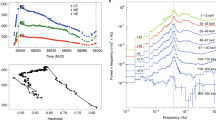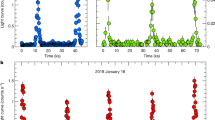Abstract
HER X-1 was observed with the Copernicus satellite X-ray detectors on June 5 this year. This date was chosen because it was predicted to be within an “extended low” of the 35-day cycle reported by Giacconi et al.1. The purpose of the observation was to search for the steady soft component, hypothesized2,3 to account for the persistence through the “extended lows” of the ∼1.5 mag amplitude, 1.7 d period, optical variations which are generally attributed to heating of one face of the companion star by the X-ray source. We report here the unexpected result that Her X-1 was detected in the 4 to 12 keV channel (overlapping with the energy range covered by Uhuru), at an intensity comparable with the previously measured “high state” intensity.
This is a preview of subscription content, access via your institution
Access options
Subscribe to this journal
Receive 51 print issues and online access
$199.00 per year
only $3.90 per issue
Buy this article
- Purchase on Springer Link
- Instant access to full article PDF
Prices may be subject to local taxes which are calculated during checkout
Similar content being viewed by others
References
Giacconi, R., Gursky, H., Kellogg, E., Levinson, R., Schreier, E., and Tananbaum, H., Astrophys. J. (in the press).
Avni, Y., Bahcall, J. N., Joss, P. C., Bahcall, N. A., Lamb, F. K., Pettick, C. J., and Pines, D., Astrophys. J. (in the press).
Pringle, J. E., Nature phys. Sci., 243, 90 (1973).
Author information
Authors and Affiliations
Rights and permissions
About this article
Cite this article
FABIAN, A., PRINGLE, J. & REES, M. Long-term Behaviour of Hercules X-1. Nature 244, 212–213 (1973). https://doi.org/10.1038/244212a0
Received:
Published:
Issue Date:
DOI: https://doi.org/10.1038/244212a0
This article is cited by
-
Celestial binary X-ray sources
Space Science Reviews (1976)
-
Anomalous temporal behaviour of Her X-1
Nature (1975)
-
Oblique rotators in binary systems
Nature (1975)
-
The 35-day Cycle of HZ Herculis
Nature Physical Science (1973)
-
Thirty-five-day Periodicity in Her X-1
Nature Physical Science (1973)
Comments
By submitting a comment you agree to abide by our Terms and Community Guidelines. If you find something abusive or that does not comply with our terms or guidelines please flag it as inappropriate.



